Mens Islamic Dress Guide Essential Styles and Modern Trends

Men’s Islamic dresses represent modesty, elegance, and cultural identity, deeply rooted in Islamic traditions. From the classic thobes and kurtas to modern variations, these garments are designed to reflect both spirituality and simplicity. They are crafted for comfort, often using breathable fabrics suitable for daily wear as well as special occasions. Beyond fashion, Islamic attire for men emphasizes dignity and adherence to faith while maintaining a timeless sense of style.
These clothes come in various styles and fabrics, adapting to different climates and personal preferences. From simple, traditional white thobes to modern designs tailored for comfort and style, the options accommodate a wide range of needs while maintaining religious guidelines.
Understanding the variety and significance of these garments helps in making informed choices about appropriate attire. This knowledge supports a respectful practice of faith and appreciation for diverse cultural expressions within the Muslim community.
Essentials of Mens Islamic Dress
Men’s Islamic dress centers on modesty, comfort, and cultural expression. Clothing choices emphasize simplicity and respect while aligning with religious teachings. Fabric, style, and symbolism all play key roles in defining appropriate attire.
Principles of Modesty
Modesty is the foundation of Islamic dress for men. Garments must cover the body from the navel to the knees at minimum, often extending further to ensure full coverage. Loose-fitting clothing is preferred to avoid accentuating the shape of the body.
Clothing should avoid flashy designs or excessive decoration to maintain humility. The purpose is to promote decency and restraint, reflecting a man’s faith and self-respect. Men are encouraged to choose outfits that balance comfort with a dignified appearance.
Islamic teachings, drawn from the Quran and Hadith, stress that clothing serves to protect personal dignity and represents a form of worship through obedience to God’s guidance on attire.
Common Fabrics and Materials
Cotton and linen are the most widely used fabrics for men’s Islamic clothing due to their breathability and comfort, especially in warm climates. These materials allow for ease of movement and reduce irritation during daily prayers and activities.

Wool is another traditional fabric but is less common in hotter regions. Synthetic blends may be used occasionally for durability but are generally less favored because they can trap heat.

Colors tend to be neutral or earth tones like white, beige, and gray, which align with simplicity and modesty principles. Fabrics are selected for their quality and ability to look neat while meeting religious criteria.
Cultural Significance
Islamic dress reflects more than religious rules; it also conveys cultural identity. Different regions incorporate local customs, resulting in varied styles like the thobe, kurta, or jubba, which carry unique historical meanings.
Clothing choices often indicate social status, occasion, or professional role. For example, a plain white thobe might be everyday wear, while embroidered garments might be reserved for special events or religious ceremonies.
Wearing traditional Islamic attire fosters a connection to community and heritage. It supports a visible expression of faith that is respected and recognized across diverse Muslim societies.
Traditional Islamic Clothing Styles
Men’s traditional Islamic clothing varies by region but consistently emphasizes modesty, comfort, and adherence to religious guidelines. These garments are typically loose-fitting and long, designed for both daily wear and special occasions.
Thobe and Jubba
The thobe is a long robe commonly worn in many Arab countries. It usually reaches the ankles and has long sleeves, typically made from cotton or polyester blends to suit warm climates. The thobe is often white but can come in other colors depending on regional preferences.

The jubba is similar but often features a slightly different cut or embellishments. It sometimes refers to a more formal or decorative outer robe worn over other garments. Both garments emphasize modesty and are easy to wear in various settings, combining tradition with practical needs.
Kandura and Dishdasha
The kandura, also known as the dishdasha in some regions, is popular in the Gulf states. It shares similarities with the thobe but may have subtle differences in collar styles or stitching.

Typically made from light fabrics, the kandura suits hot climates and is commonly white or beige. Both garments are an everyday staple, symbolizing religious devotion and cultural identity. They are worn with sandals or simple footwear and sometimes paired with head coverings like the ghutra.
Galabeya
The galabeya is a traditional robe found predominantly in Egypt and parts of North Africa. It often has a looser fit and may include brighter colors or patterns compared to Gulf attire.

This garment is versatile and worn in both casual and formal environments. Jalabia is made of cotton or linen, supporting comfort in warm weather. The galabeyas stands out for its cultural distinctiveness within Islamic men’s clothing, reflecting regional aesthetics alongside religious modesty.
Contemporary Trends in Men’s Islamic Fashion
Men’s Islamic fashion today reflects a balance between respect for tradition and the demands of modern life. Designs emphasize modesty, comfort, and functionality, while incorporating subtle elements that appeal to contemporary tastes.
Modern Influences
Modern Islamic fashion integrates minimalist aesthetics with traditional clothing. Neutral colors like white, beige, and charcoal dominate, favored for their versatility and understated elegance. Designers often include subtle embroidery or tailored cuts that enhance the garment’s form without compromising modesty.
Materials have evolved, with a focus on breathable, lightweight fabrics suitable for urban environments. This approach supports both religious practices and the need for practicality in daily wear.
Technological advances have also shifted purchasing habits, as many men now buy Islamic clothing from specialist online retailers, allowing access to diverse, quality options globally.
Blending Tradition and Style
Men’s Islamic dress today respects longstanding cultural and religious values while embracing contemporary stylistic elements. Traditional garments such as thobes and shalwar kameez maintain their core design but are often adapted with refined tailoring and modern finishes. This keeps the attire appropriate for both religious contexts and social or professional settings.
This fusion allows men to express their faith visibly while aligning with current fashion trends. The garments remain modest but avoid appearing outdated, creating a balanced look that appeals across generations.
The emphasis on layering and accessories, such as keffiyehs or shemaghs with updated patterns or materials, further supports this blend, making traditional attire more versatile.
Popular Urban Outfits
Urban Muslim men prefer outfits that combine modesty with practicality and style. Key pieces include contemporary thobes with clean lines and lightweight fabrics. These are often paired with modern footwear and minimalistic accessories.

Casual Islamic wear might also feature modest pants and tunics tailored for comfort in city life. Functional, stylish hijabs and headgear adapt to metropolitan fashion without losing traditional significance.
Brands cater to this demand by offering collections that prioritize ease of movement and durability, alongside fashionable elements like muted patterns and monochromatic palettes. This trend acknowledges the need for Islamic clothing that fits seamlessly into an urban wardrobe.
Regional Variations in Men’s Islamic Dress
Men’s Islamic dress reflects not only religious principles but also local customs and climate. Fabric choices, garment styles, and fitting often vary widely, shaped by regional cultures and traditions.
Middle Eastern Clothing
In the Middle East, men commonly wear the thobe (also called dishdasha or kandura). This ankle-length garment is usually white or light-colored to reflect sunlight and keep cool in hot climates. It has a loose fit to ensure modesty and comfort.

The ghutra or keffiyeh often accompanies the thobe. This traditional head covering, secured with an agal cord, protects from sun and sand. Some regions favor specific patterns or colors for these headpieces, signaling tribal or national identity.
Materials range from lightweight cotton to silk blends for fashion or formal occasions. The overall design remains simple yet elegant, adhering strictly to Islamic guidelines for modesty.
South Asian Garments
South Asian Muslim men often wear the kurta, a knee-length tunic made from cotton, silk, or blended fabrics. The kurta features a straight cut with side slits for ease of movement, worn over loose-fitting shalwar or trousers.

During special occasions, the sherwani, a more formal jacket-like garment, is popular. Embroidery and intricate designs distinguish these garments, showcasing cultural artistry within Islamic modesty rules.
Head coverings in South Asia may include skull caps, called taqiyah or topi, reflecting piety and cultural tradition. The fabrics used are generally thicker than in the Middle East, suited to the local climate.
African Islamic Clothing
In African Muslim communities, traditional dress varies significantly but shares a focus on modesty and practicality. The boubou or djellaba is a loose, flowing robe worn in West and North Africa. It often features wide sleeves and detailed embroidery around the collar and cuffs.

Colors and designs can be vibrant, reflecting local aesthetics. Headwear might include turbans or caps, crafted from woven fabrics native to the region.
The garments suit different climates, balancing breathability and coverage. They serve both daily wear and ceremonial purposes, marking social status or ethnic identity within Islamic dress codes.
Maintaining and Caring for Islamic Attire
Proper care for Islamic clothing preserves its modesty, cleanliness, and overall dignity. Attention to cleaning and storage helps maintain the garment’s quality and respects the religious significance attached to the attire.
Cleaning Guidelines
Islamic attire for men should be cleaned regularly to maintain purity and hygiene. It is recommended to use gentle detergents suitable for delicate fabrics to avoid damage. Washing in cold or lukewarm water helps protect the fabric’s integrity and color.
Just as reciting Surah Fatiha reminds a believer of the importance of purity in worship, keeping one’s clothes clean reflects the same spirit of cleanliness in daily life.
Avoid using bleach or harsh chemicals, especially on white garments, as they can weaken the fabric fibers. Clothes should be washed separately if possible, to prevent color transfer and maintain cleanliness.
Delicate items like embroidered or finely woven fabrics require hand washing or the use of a gentle machine cycle. After washing, it’s important to dry the clothes in the shade to prevent fading and fabric deterioration.
Storage Tips
Islamic garments should be stored in a clean, dry place to avoid moisture and mildew, which can damage fabric and promote unpleasant odors. Hanging garments like thobes or jubbas on wide, padded hangers helps maintain their shape.
Folding heavier clothing and storing them flat prevents creases and fabric stretching. It is advisable to avoid plastic covers, as they can trap humidity, instead using breathable fabric garment bags.
Keeping clothes away from direct sunlight prevents discoloration. Periodic airing helps maintain freshness, especially if the attire is worn infrequently. Using cedar blocks or sachets can protect against insects naturally.
what is modest clothing men?
Modest clothing for men refers to attire that covers the body appropriately without being tight, flashy, or revealing. In many cultures, especially Islamic tradition, it includes loose-fitting garments like long shirts, thobes, kurtas, or trousers that ensure dignity and simplicity. The goal is to dress respectfully, avoiding arrogance or extravagance, while maintaining comfort and a neat appearance. You can purchase Islamic dresses from different brands like https://m.modanisa.com.





